General Information
Illustrated Body Language Guide
This guide mostly uses budgie pictures but the same behavior patterns are found in many other species too.
Affection
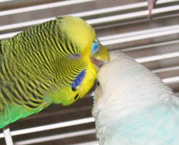 |
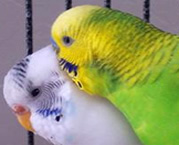 |
Mutual Preening = "I love you!"
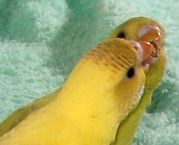 |
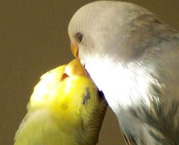 |
Kissing (left) and regurgitation (right). Do not confuse this with vomiting! Vomiting is an uncontrolled process (the bird will stain his feathers) whereas regurgitation is aimed at the mouth and is a rather neat process.
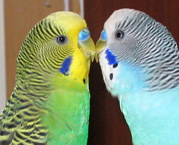 |
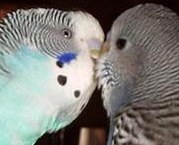 |
"Beaking" = Tapping on the beak of a partner rapidly. A friendly gesture usually prior to kissing and/or regurgitation. Other signs of affection include nibbling on the owner's hand
Aggression
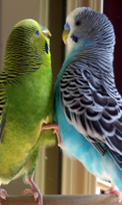 |
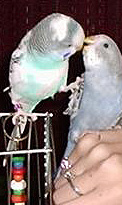 |
Aggression stance: (above photos) flatten plumage, raised body, stretched spin, cocked head with one leg on the opponent's chest. They try to intimidate their opponent by seeming looking taller.
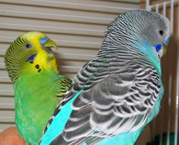 |
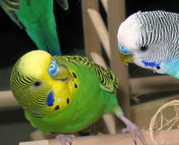 |
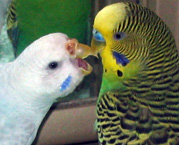 |
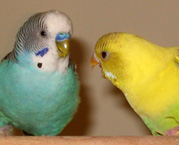 |
Deffensive or warning stance: (above photos) poised body, usually accompanied by an open beak.
Asking for a head scratch
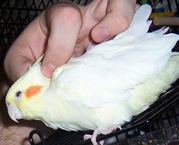
As flexible as birds may be, they cannot reach the top of their own head and so require someone else to do it. The bird will stick his head forward with his head bowed down towards his human or another bird. If no head scratched given, the bird usually makes soft begging-chirps.
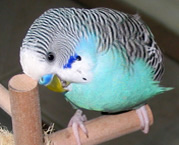 |
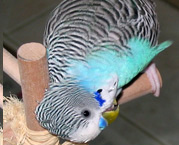 |
If his request is further denied (whether it is because there is no one around or the plea has gone un-noticed), the bird will usually rub his head against an object or perch. This is done to relieve itching and to compensate for lack of mutual preening if the bird is kept as a single pet.
Bored
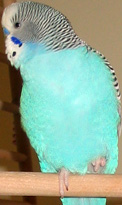 |
When the bird is standing on one leg without sleeping or chattering, he is most likely bored. If this stance is accompanied by chirping or beak grinding, he is most likely content and relaxed and should be found sleeping shortly afterwards. Cockatiels show that they are bored or unhappy by flattening their crest (bottom right photo) |
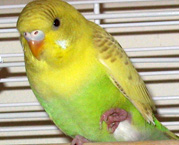 |
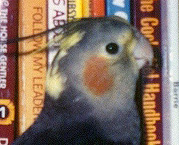 |
Cocked head
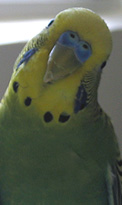 |
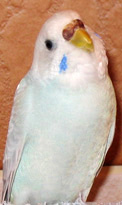 |
Birds cock their head to produce a sharper image of whatever they're looking at on their fovea. When they do this, it usually means they are curious about something.
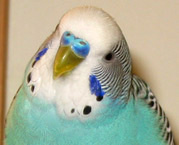
Contented
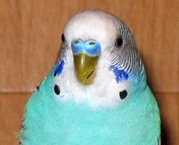 |
 |
Beak grinding (left photo): is the most obvious sign of a happy bird. Birds are usually seen to do this before they fall asleep.
Relaxed (right photo): the bird is standing on one leg and chattering. If the bird is standing on one leg and not doing anything, then he is bored. It is dangerous for birds to stand on one leg in the wild because it delays their escape response by a couple of milliseconds at the onset of a predator. Even such a small escape delay could cost them their lives. A bird standing this way is either relaxed, bored, or ready to go to sleep.
Cooling off
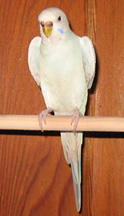 |
Usual cooling down stance: Birds cannot sweat
and so depend on air to reach the underside of the wings to cool
down. When over heated, they will be seen holding their wings
away from their body (the hotter they are, the further away from
their body). Their plumage will be flattened as well (the last
thing they want is more heat getting traped by their feathers!)
|
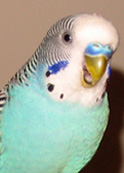 |
Panting: Birds, like dogs and many other
animals, pant to get rid of excess heat. They are usually seen
panting with the stance described above. However, panting (or
hyperventilating) is also sign of nervousness as well.
|
Courtship
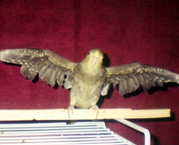 |
Attraction: cockatiels are known to spread
their wings out fully. When they do this, they are usually
trying to impress the opposite sex. They also do this to
intimidate a rival or show off just for fun.
|
 |
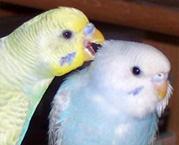 |
Affection: birds do many things to show that they care about another bird. This includes feeding (regurgitation - left photo) and mutual preening (right photo). They often do this to woo their mates and it is usally the males that perform for the females.
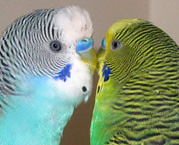 |
Mating dance: most birds have their own unique
mating dances. Budgies tend to bob their head, side step on the
perch very rapidly, pluff their feathers up, and tap his
partner's beak.
|
Excited
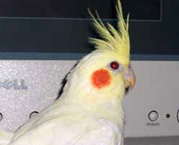 |
Raised crest : a cockatiel's crest position
give a lot of information on their mood. When the crest is
raised, it usually indicates a happy, active, and excited bird.
|
 |
Pupil dilation: Pupil dilation means many
things, but among the signs it is one that states "I am very
excited!"
|
Another sign of excitation is rapid side stepping (running back and forth on the perch rapidly). Many birds do this when they see their human(s). Feathers are also usually stood on ends during a state of excitation.
Exercising
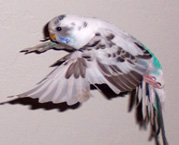 |
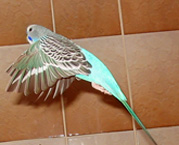 |
Flying is the primary way birds exercise. Except for finches, birds should be let out of their cage at least an hour a day. Clipping does NOT prevent birds from exercising via flying (see photo on the right - that bird is clipped!) . If the bird is getting inadquate amount of exercise, he will grip the perch with his feet and flap his wings vigorously.
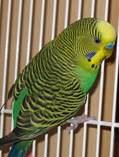 |
Climbing: Finches and canaries do not climb for
exercise, rather they hop from perch to perch. However, all
other small birds climb as a means of getting to places and
exercising. This is why it is highly recommended that you get
the appropriate bar spacing for your specific bird species. The
wrong bar spacing can strain their feet.
|
Eye Pinning
 |
 |
Eye pinning is the dilating the pupil (see the left bird in both photos above). It indictates that the bird has seen something that appeals to him and is excited. It is also a warning signal to not come any closer otherwise he will bite. In cockatiels, this warning signal is often accompanied by flattened or fully puffed out crest and a loud hiss.
Feeling uncomfortable
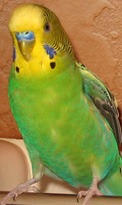 |
Uncomfortable: the bird will lift his wings
very slightly away from his body and then pull it back rapidly.
Sometimes it makes a quiet "snap" sound when he does this. Do
not confuse this with cooling down or stretching. If he is
cooling down, he will let his wings linger away from his
body and does not rapidly pull it back. If he is
stretching, his wings will be pulled out very far back (not
completely opened all the time).
|
 |
Cockatiels show that they are uncomfortable or unhappy by flattened crests. |
Another sign that the bird is uncomfortable is in posture. Sometimes he will stand on one feet and swtich his feet constantly. This usually indicates that the perch he is standing on is uncomfortable.
Nibbling feet
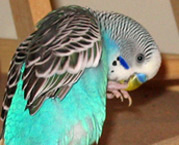
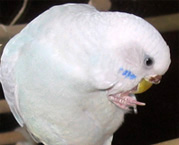 |
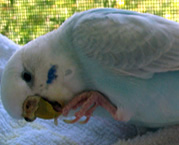 |
Birds do this all the time and it is usually not something to worry about. However, if he is nibbling on it so often that it turns red or has scales, a vet visit is called for.
Nibbling of the feet (commonly called "feet picking") is a grooming gesture. It is done to keep the feet moisturized and elastic. It is also done to massage the feet (birds spend 24/7 on their feet!).
Preening
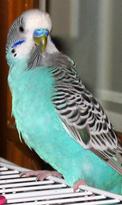 |
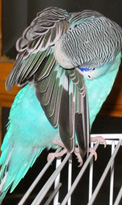 |
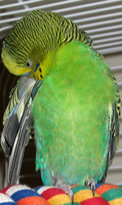
|
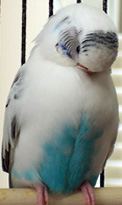 |
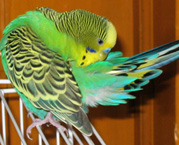 |
Pirds preen to put feathers into place. It is a process whereby feathers are "zipped together". Worn out feathers, dirt, and dead cells are also discarded in this process. Birds are very flexible and can reach all around their body (except for their head). The bird will often touch an oil gland at the base of his tail (called the uropygial) with his beak or rub his head over it (as demonstrated in the bottom right photo). He picks up oil which the gland secretes and spreads it all over his body and his legs. This oil keeps his feet moisturized, elastic, and makes his feathers waterproof (have you ever noticed that your bird does not get wet when you try to force a bath on him sometimes?).
Do not confuse preening with feather plucking: the act of pulling out feathers that need not be replaced or discarded, leaving exposing areas to his skin (bald spots). It is an indication of a troubled and most likely ill bird.
Rearranging crop content
Sometimes, usually after a meal, the bird will sit on a perch and open and close his beak with his neck streching and contracting. He will do this for a couple of seconds or sometimes several minutes. Birds store their food in their crop and sometimes it goes not go down right and needs rearrangement. Other times this motion is done to help lubricate the seeds in the crop to help digestion.
Scared/Startled/Nervous
When a bird is scared or startled, he will go very thin and flatten his plumage.
Scratching
Birds, like all animals, scratch when they are itchy. Birds have flexible joints which allows them to pull their leg under and over their wings to scratch. They can scratch any part of their bodies (either with their legs or their beaks) except their head. It is important to keep the bird's nails trimmed because sharp nails can cause injury while the bird is scratching in rapid motion.
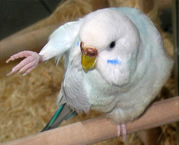 |
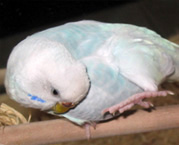 |
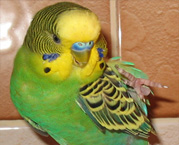 |
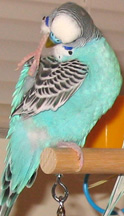 |
Shaking plumage/fluffing
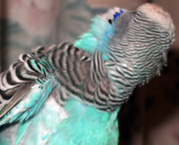 |
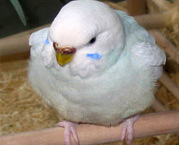 |
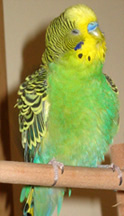 |
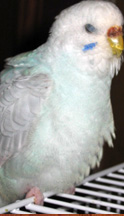 |
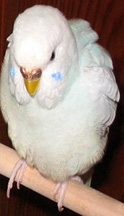 |
Shaking of plumage: (all photos above except bottom right photo) all feathers are shook (head to toe) and then returned to its normal position within seconds. This is done to get rid of dirt and bits of dead skin, to get rid of water after a bath, or a sign of mood change (ie before flying or engaging in an acitivty). The most common reason for shaking is to relieve tension and stress (most commonly seen when the bird is new or does not yet trust its human).
Showing off
Birds show off for one dominating reason - to get attention. Males usually show off to attract a mate. Either sex might show off to get their owner(s) attention. Different birds portray different body language. Tiels are known to hold their wings out.
 |
Sitting on door
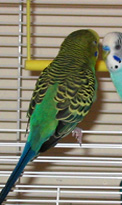 |
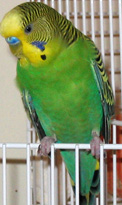 |
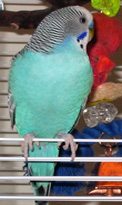 |
This is really not a behavior per se, but many birds absolutely love doing it. They will even take naps there. .
Sleeping
For deep sleep, such as sleep for the night, birds usually tuck their bills behind their wings and stand on one leg. See photos below.
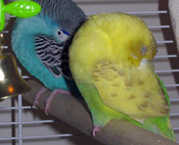 |
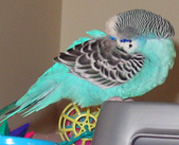 |
For naps, birds tend to stand upright and close their eyes (see photos below).
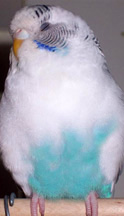 |
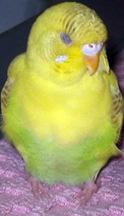 |
These two are the most common sleeping positions, but there are many odd positions as well. Some birds, especially baby birds, like to sleep lying down with their feet pulled in under their wings (see photo below).
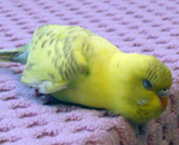
Finches sleep in nests piled on top of each other. Other birds prefer to sleep clinging to the cage bar.
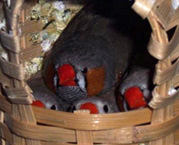
Stretching
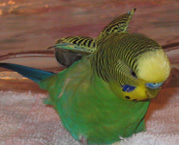 |
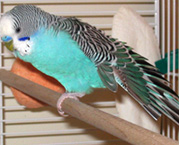 |
Birds stretch very frequently and spontaneously. They usually do so after a period of inactivity, such as after a nap. Stretching occurs in many ways. The bird can lift both his wings up and down one or several times (left photo) or extend his wings fully to one sigh with his leg under it (right photo).
Tail bobbing/fanning
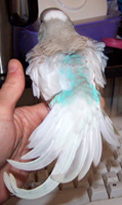
Tail fanning/waving (photo above): performed, usually by the male, during courtship. It can also be a sign that the bird is nervous.
Tail bobbing: (up and down motion of the tail in rhythm with heavy breathing) shows that the bird is petrified or very stressed. If this continues for a long period of time, it indicates respiratory problems and the bird should be taken to the vet.
Various calling sounds
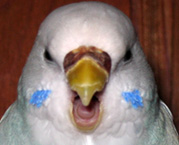
The following is the calling sounds described for budgies. Other species may have different calling sounds.
Fear/attack sound: cackling sounds.
Warning call: high pitched shrill.
Angry call: shrill, loud, and rapid chirps.
Happy/relaxed: soft chirps
Screeching: high pitched and long wail. Wild budgies do not screech (they do not want to draw predators' attention to their colony). Screeching is theorized to let out excess energy for being caged birds
Yawning
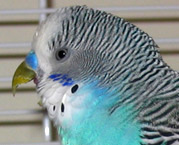
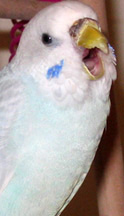 |
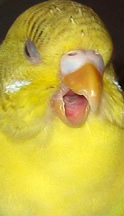 |
Like other animals, birds yawn when there is a lack of oxygen or when they are sleepy.
